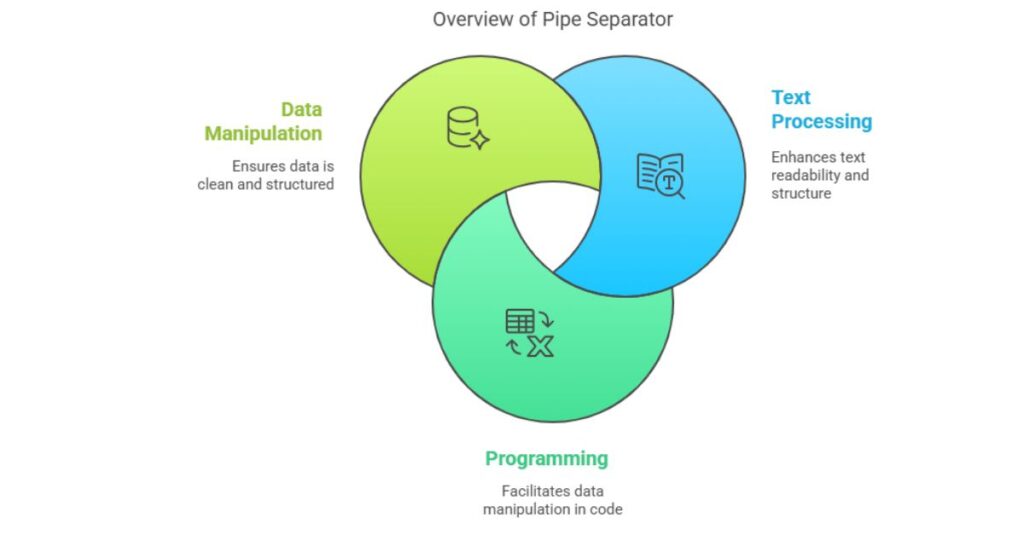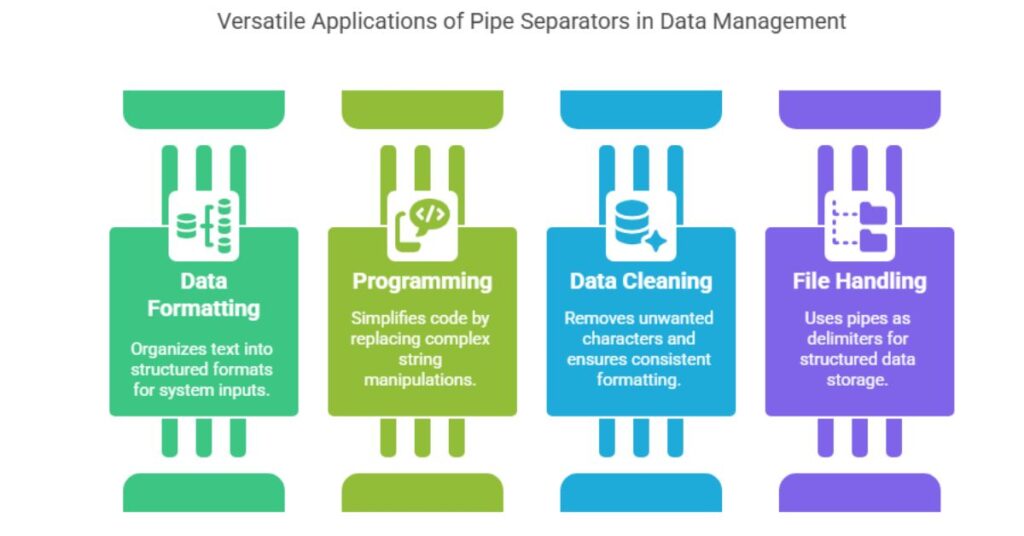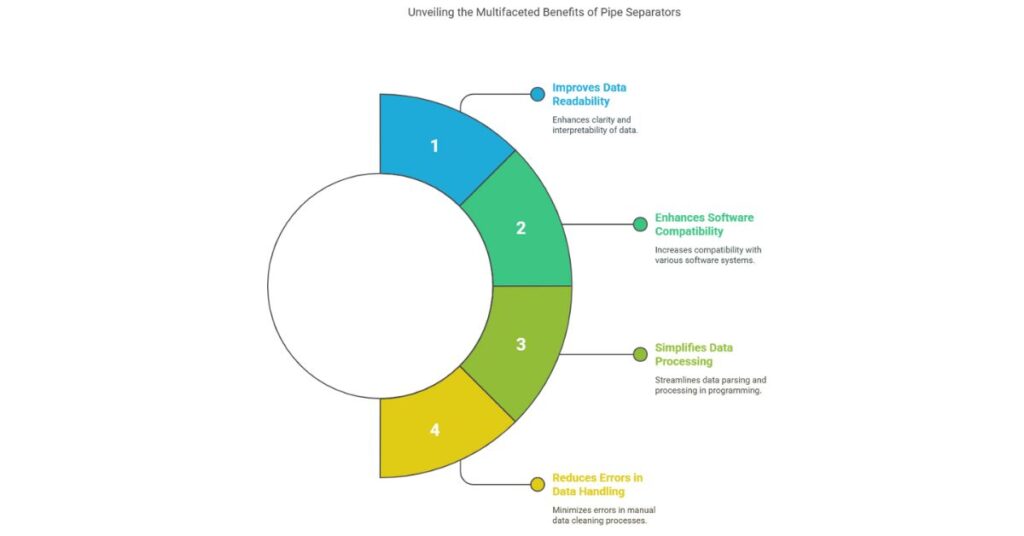Pipe Separator Tool
Example Input: “Apple,Banana;Grapes|Mango”
Table of Contents
Introduction to Pipe Separator

A pipe separator is a tool that formats text by replacing special characters or punctuation with pipes (|). It is widely used in text processing, programming, and data manipulation. This tool ensures the text is clean, structured, and easy to use in multiple applications.
How It Works
This tools uses a simple process to transform text:
- It scans the input string for non-alphanumeric characters.
- It replaces those characters with the pipe symbol (
|). - It removes extra separators to produce clean output.
For example, if the input text is Apple,Banana;Grapes|Mango, the pipe separator converts it to Apple|Banana|Grapes|Mango. This process organizes data into a structured format, making it easier to process and analyze.
Applications of the tools

1. Data Formatting
These tools are commonly used to structure data. They organize text into pipe-separated values, which can be used as input for various systems. Software tools, such as databases and machine learning models, often require well-structured data.
2. Programming
In programming, these tools helps developers process strings or format log files. It simplifies code by replacing complex string manipulations with straightforward piped text.
3. Data Cleaning
When working with raw datasets, you may encounter unwanted characters or inconsistent formatting. A pipe separator cleans the data by removing unnecessary symbols and formatting it consistently.
4. File Handling
Pipe-separated values are used in files for structured storage. For example, instead of using commas or tabs, pipes act as delimiters to separate data fields.
Benefits of Using
1. Improves Data Readability
This tools create clear and structured text. This makes data easier to read and interpret for both humans and machines.
2. Enhances Software Compatibility
Many tools and systems support pipe-separated values. This makes data formatted with pipes more compatible with software applications.
3. Simplifies Data Processing
Pipe-separated data is easier to parse and process in programming. This saves time and reduces errors.
4. Reduces Errors in Data Handling
By automating the replacement of special characters with pipes, a pipe separator reduces errors in manual data cleaning.
Step-by-Step Guide

1. Collect Input Text
Start by gathering the input text. The text may contain commas, semicolons, or other special characters.
2. Identify Special Characters
Use regular expressions to identify non-alphanumeric characters in the text. Regular expressions are efficient in detecting patterns in strings.
3. Replace Characters with Pipes
Replace all the identified characters with the pipe symbol (|). Ensure that the replacement does not leave consecutive pipes.
4. Remove Extra Pipes
Remove multiple consecutive pipes and trim unnecessary spaces in the output. This ensures clean and consistent formatting.
5. Display the Output
Show the final pipe-separated output. Provide options for the user to copy, save, or reuse the formatted text.
Example: Pipe Separator in JavaScript
Here is an example of how to create a pipe separator using JavaScript:
javascript
function pipeSeparator(input) {
// Replace special characters with pipes
const result = input.replace(/[^a-zA-Z0-9]+/g, '|').replace(/\|+/g, '|').trim();
return result;
}
// Example usage
const inputText = "Apple,Banana;Grapes|Mango";
const outputText = pipeSeparator(inputText);
console.log(outputText); // Output: "Apple|Banana|Grapes|Mango"
This function demonstrates how to clean and format text using regular expressions. It ensures all non-alphanumeric characters are replaced with pipes, and consecutive pipes are reduced to a single pipe.
Best Practices for Using a Pipe Separator
1. Test with Different Inputs
Test the tool with various types of input text to ensure it handles all cases, including empty strings, special characters, and large text.
2. Handle Edge Cases
Consider edge cases, such as text with only special characters or text that already uses pipes. Ensure your implementation produces clean and expected output.
3. Use Efficient Code
For large datasets or real-time applications, optimize the code to handle data efficiently. Use algorithms that reduce processing time.
4. Provide User-Friendly Interfaces
If building a pipe separator tool, ensure the interface is easy to use. Include clear instructions and features like copy, paste, and save options.
Challenges in Using a Pipe Separator
1. Processing Large Datasets
Large datasets can take time to process, especially if they contain millions of characters. Optimizing the code is crucial for handling such scenarios.
2. Handling Complex Patterns
Some text may include complex patterns, such as dates, file paths, or code snippets. These patterns may require special handling to preserve meaning.
3. Maintaining Data Integrity
Replacing characters with pipes can sometimes cause unintended data changes. For instance, replacing commas in a CSV file might corrupt its structure.
Conclusion
A pipe separator is a valuable tool for text formatting, programming, and data cleaning. It transforms text by replacing special characters with pipes, making it cleaner and easier to use. As a CSE professional, understanding and implementing a pipe separator can help you efficiently process and organize data for various applications. With proper testing, optimization, and attention to edge cases, a pipe separator can save time and improve the quality of data handling tasks. Whether you are formatting log files, cleaning datasets, or working on software development, a pipe separator is a practical and essential solution.